13 June, 2000
13 June 2000
Ice Impressions and Helo Heaven.
Last night I spent two hours on the foícísle (bow, front) of the boat
watching the ship break through seasonal sea ice. Let me try to give an
example of what this is like. Picture yourself sitting above a table with
an assembled jigsaw puzzle on it. Now imagine that the jigsaw puzzle is
various shades of white. Then visualize sliding your hand along the
tabletop and gradually breaking a path through the puzzle. If you throw in
pressures of varying amounts from all the other sides of the puzzles
occurring at various times, you have generated a picture of what it has been
like breaking through the ice we are in now.
Large (house lot to city center sized) sheets of ice, called floes, make up
a patchwork of ice cover in this area we are currently in between Greenland
and Baffin Island, Canada. Open channels of water, called leads, appear
between the sheets of ice as the wind and tides push and pull at them. In
areas where the floes push against each other pressure ridges form like
puzzle pieces being crushed together. These pressure ridges are two or more
times as thick as the surrounding ice, but still give the ship only slightly
more of a challenge to break through than the floes alone.
As the ship breaks the ice, you can hear it cracking and sliding down the
shipís sides as is passes. Behind the ship, a wake of crushed ice leaves a
telltale sign of where the ship has been. The deep blue waters of Baffin
Bay often appear brown as algae on the bottom of the ice (see Toddís
journal) is churned to the surface. All of these icy features are visible
from many vantage points around the ship, but today, I also saw many of them
even better from the air.
What? Thatís right, I said AIR. This afternoon I had the opportunity to
fly in one of the Coast Guardís Dolphin (Dauphin) Helicopters. We took off
from the helo pad near the stern (back) of the ship and spent 45 minutes
over the ice looking at sea ice features, icebergs, and for marine mammals.
The first two were interesting, the last inspiring. A morning
reconnaissance flight had turned up a polar bear and a narwhal. We didnít
see the bear on our flight but had a wonderful look at a male narwhal. I
was in biologist heaven. Narwhals are toothed whales similar to the white
Beluga whales of the arctic and are found only in the high arctic. Narwhals
have spotted skin and the males have an elongated incisor that spirals out
in front of its head to form a tusk. The tusk makes narwhals look like the
cetacean (whale) equivalent of a swordfish, and gives them the nickname
ďunicorn of the seaĒ. Ever since I learned about narwhals as a kid I have
dreamed about seeing one in the wild, a dream come true courtesy of the
aviation attachment of USCGC Healy.
Tomorrow we will get back to the science of mooring, the second of which we
deployed this afternoon. I just had to share these arctic visions with you
while they were fresh in my mind - not that I will soon forget any of them!
Note: I was using 35mm film for the narwhal. Sorry no digital images of it.

Polar bear tracks are visible crisscrossing the ice throughout our path. The smaller print would easily hold by size 12 boots!.
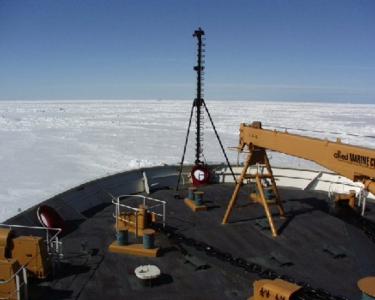
Off the bow (front of the ship) nothing but ice and a few leads.
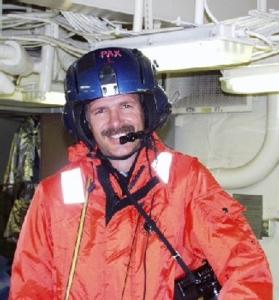
Ready for flight - Right Into The Narwhal Zone! (photo by Todd Hindman)

No, we didn't run over the polar bear. Just its tracks.
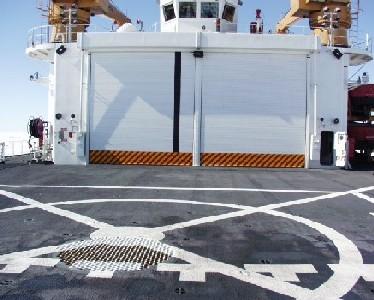
Helo Hangar. Was shooting 35mm film during helo operations today. Will try to add live shots later.
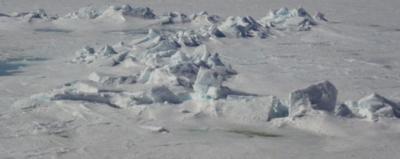
One of the pressure ridges formed between two colliding floes.

Broken blocks of ice slide past the starboard (right) side of the ship.

The Coast Guard Dolphin/Dauphin helicopter in "resting" mode - blades folded and nose up in the hangar

The icy wake of the USCGC Healy - 420 feet of icebreaking steel!
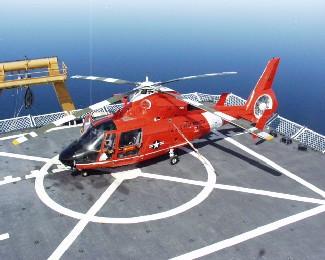
Here is a little better picture of one of the Healy's helos.
Contact the TEA in the field at
.
If you cannot connect through your browser, copy the
TEA's e-mail address in the "To:" line of
your favorite e-mail package.
|
